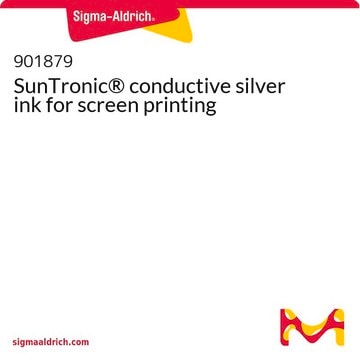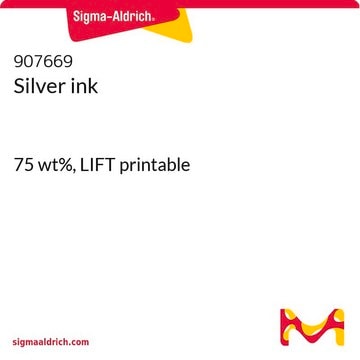There is no specific information available on the exact drying time after printing ink. Overnight drying is generally recommended, but it is important to consider the substrate and environmental conditions, as these can influence the actual drying time. If precise drying time is required, conducting a test on the specific substrate used may provide better guidance.
791873
Conductive silver printing ink, resistivity 5-6 Ω cm
Sinonimo/i:
Greatcell Solar®, Dyesol(R) DYAG50 conductive silver ink, Screen printable silver paste
Scegli un formato
Scegli un formato
About This Item
Prodotti consigliati
Descrizione
volume resistivity 5 - 6 Ω cm
Livello qualitativo
Saggio
75-85% solids basis
Stato
paste (white)
Viscosità
13,000-17,000 mPa.s (at shear rate of 10 sec-1 at 25°C)
Descrizione generale
Applicazioni
This Conductive Silver Printing Ink is a specially formulated ink which provides exceptionally high conductivity at low cure temperatures. This highly conductive ink provides extremely low resistance printed conducting tracks, essential for the photovoltaic applications. By providing the lowest track resistances of printed current collectors, this material is a key enabler in plastic electronics, such as, DSSC, OPV, and CdTe solar cells.
Note legali
GreatcellSolar is a registered trademark of Greatcell Solar Materials Pty Ltd.
Avvertenze
Warning
Indicazioni di pericolo
Consigli di prudenza
Classi di pericolo
Aquatic Acute 1 - Aquatic Chronic 1 - Eye Irrit. 2 - Skin Irrit. 2
Codice della classe di stoccaggio
10 - Combustible liquids
Classe di pericolosità dell'acqua (WGK)
WGK 3
Punto d’infiammabilità (°F)
174.2 °F
Punto d’infiammabilità (°C)
79 °C
Scegli una delle versioni più recenti:
Possiedi già questo prodotto?
I documenti relativi ai prodotti acquistati recentemente sono disponibili nell’Archivio dei documenti.
I clienti hanno visto anche
Articoli
The ability to pattern conductive electrodes is technologically relevant for several applications, including photovolatics, displays, sensors, and biomedical devices.
Small molecular weight organic semiconductors are promising for flexible transistor applications in next-gen soft electronics.
Dye-sensitized solar cells (DSCs) are 3rd generation solar cells combining the promise of high efficiency with low production costs.
Professors Tokito and Takeda share design principles and optimization protocols for organic electronic devices, focusing on flexibility and low cost.
-
How long does it take to dry naturally after printing ink?
1 answer-
Helpful?
-
-
What is the particle size distribution of the colloidal silver in this ink? What would be the best solvent to use to remove the residual ink from a screen printing mesh?
1 answer-
This item is a product of Greatcell Solar Materials. The manufacturer considers the particle size distribution to be proprietary. The preferred solvent for the removal of residual ink is ethanol. However, the end-user should ensure that the screen material is compatible with the ethanol and ink components before use. The ink components can be found in the product Safety Data Sheet.
Helpful?
-
Active Filters
Il team dei nostri ricercatori vanta grande esperienza in tutte le aree della ricerca quali Life Science, scienza dei materiali, sintesi chimica, cromatografia, discipline analitiche, ecc..
Contatta l'Assistenza Tecnica.












